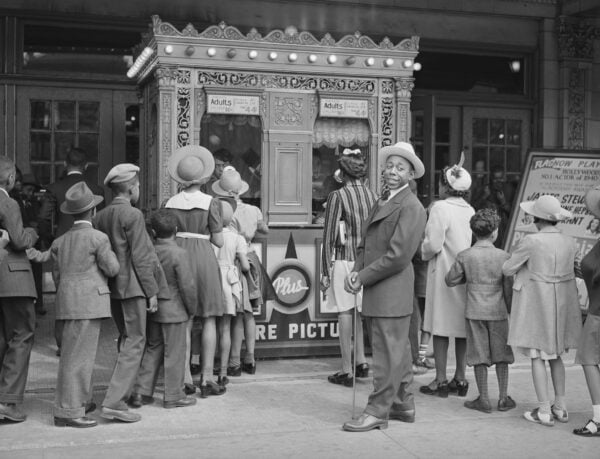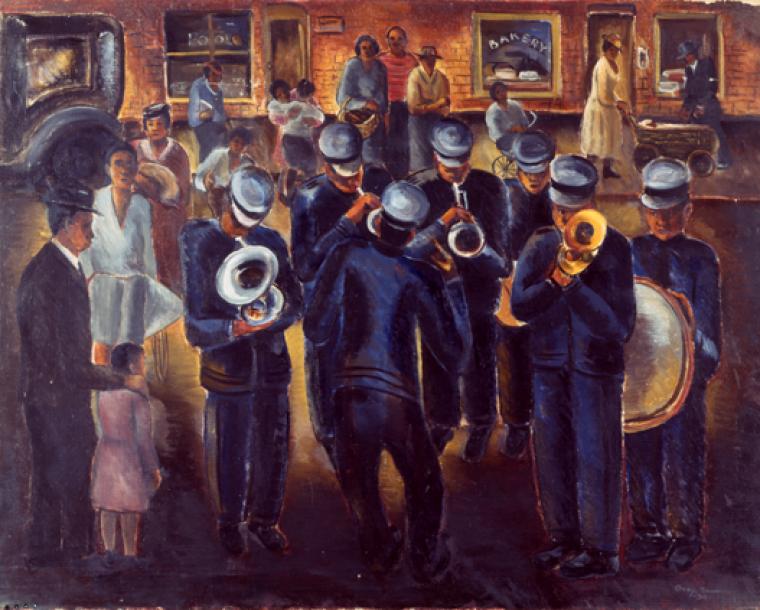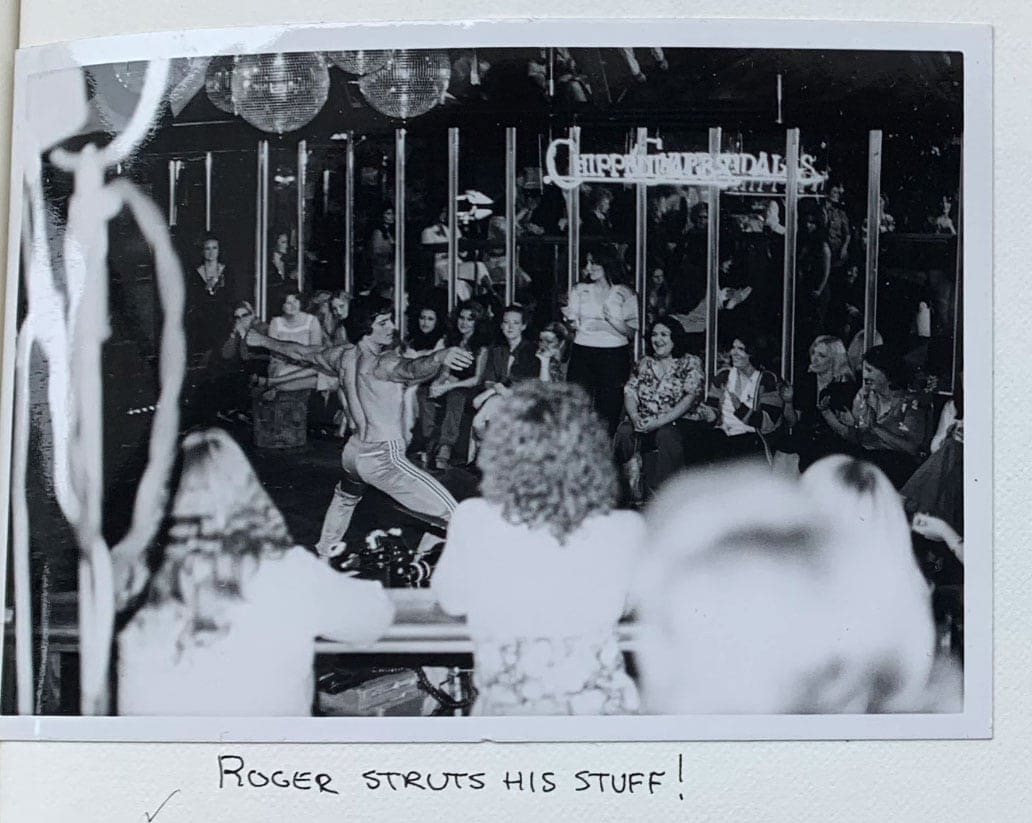It all started with Nicolas Cage.
In July 2018, Jason Herbert, a doctoral candidate in history at the University of Minnesota, wanted to watch the 2004 film National Treasure with some friends—online. He tweeted from his account @HerbertHistory, “National Treasure is on Netflix again. I feel like we as historians owe it to America to jointly watch this film and live tweet it together.”

You don’t have to wait in line for a ticket at HATM. Just press play at 8:00 p.m. ET every Sunday and follow along with the hashtag on Twitter. Russell Lee/Library of Congress, 2017789014. Public domain
Little did Herbert know that this tweet would start a phenomenon. To make it easy for the historians tweeting along while watching National Treasure, Herbert created the hashtag #HATM, short for “Historians at the Movies.” At the appointed time, historians tuned in to watch Cage steal the Declaration of Independence while laughing at and bemoaning the movie’s antics together on Twitter. As Joanne Freeman (Yale Univ.) put it at the time, “THEY PUT FRICKIN’ LEMON JUICE ON THE DOI.”
The HATM community had so much fun that July evening that they asked Herbert to continue selecting films and gathering historians to live-tweet from their couches. The next week, historians tuned in for Lincoln. Then Marie Antoinette. Then Trading Places. With that, Herbert told Perspectives, “we were off to the races.”
Three years, hundreds of films, and tens of thousands of tweets later, the HATM community is still going strong. To Herbert’s knowledge, HATM has become the longest-running community watch party on social media. Every Sunday evening at 8:00 p.m. ET, this community logs on to Twitter, starts the film selected by Herbert, and enjoys the chatter. Many participants watch with their partners, and some turn it into a family movie night with their kids. Historians have also started offshoots in Australia (#HATMAus) and the United Kingdom (#HATMUK).
HATM is a passion project for Herbert, who is currently putting the final touches on his dissertation. The weekly event has offered Herbert some unique opportunities. Although he is a scholar researching the intersection of Indigenous history and environmental history, Netflix asked him to provide Twitter commentary on The King, a film about medieval knights. He gave himself a crash course on the subject and, though the topic was far outside his specialty, found the event rewarding. Thanks to his HATM experiences, Herbert has come to realize that he is, at heart, a public historian.
HATM has become the longest-running community watch party on social media.
Herbert expressed amazement at the continued growth of the HATM community and the connections forged among the participants. “What keeps me going—what keeps this thing going—is the fact that people enjoy it. The community is the most important thing. It’s the sense of togetherness that we’ve been able to create.” Herbert usually opens a HATM night on Twitter with a few questions, including asking what everyone’s snacking on, which gets the conversation rolling.
He tries to offer a balance of films, from serious to lighthearted, covering different time periods and places. “The most important thing to me when I choose films is diversity,” he said, especially “the diversity of experiences and the diversity of people represented on-screen.” He compared watching a film to conducting research in the archive. “Part of going to the archive is sussing out stories that maybe don’t appear in the archive as well. We can take a film and say, ‘Well, wait a second. This movie has a bunch of people like this, but where are the people like that? Where are women’s voices? Where are the voices of color? Who’s not being represented?’ Which is always a question we’re asking, as historians.”
Robin Mitchell (California State Univ., Channel Islands), a participant and past co-host, noted, “Jason has created a unique community. Those of us who study race and gender can add to films that may not, on the surface, lend themselves to those conversations.”
“Sometimes we handle controversial films and topics, attempt to put them in historical perspective, and critique them,” explained frequent participant Rachel Gunter, professor of history at a community college in North Texas. “Several films have been heavily critiqued for their gender or racial stereotypes. Some films lead us to discuss the history of filmmaking itself.”
Herbert noted that the films that generate feelings of nostalgia tend to provoke the most interest and commentary. Viewers hearken back to the first time they watched Star Wars, screamed at the screen during Alien, or experienced Beauty and the Beast with their children. But even films that elicit nostalgia encourage thoughtful conversation.
Many historians contribute to the insights the social media watch party has become known for. Herbert will sometimes ask a historian ahead of time to co-host or serve as a “featured tweeter” who can offer background information or historical perspectives on the film. Other times, people will volunteer to co-host if they have expertise relevant to the film. Herbert remains mindful that co-hosting takes time and energy. But it also helps scholars highlight their work and “engage with a broad audience about representations of a historical moment,” explained Jazmine Contreras (Goucher Coll.).
Contreras has co-hosted HATM three times. “Each time was a fantastic educational experience. As a memory scholar, I spend a lot of time thinking about the creation of historical narratives and why the public understands events in a particular way. Films are integral to shaping the American popular imagination. HATM gives scholars and nonscholars alike a chance to participate in knowledge production, to shape and reshape popular understandings of a film.”
Participants have also brought HATM into their classrooms. When Mitchell co-hosted a viewing of Daughters of the Dust, several of her students participated. “As a result of that event,” Mitchell said, “history students have come back for other films. What strikes me is that they will participate, even engaging with historians they respect. They feel they have a space to do that, as colleagues. It has been a confidence builder for them.”
HATM offers students a fresh way to examine history and popular culture, as well as the unique opportunity to engage with historians from every field and rank. “It’s been a great way to have students introduce themselves to scholars and participate in discussion in a relaxed and low-stakes environment,” observed Contreras, who has offered students extra credit for participating.
In addition to having a good time, HATM participants play a beneficial role in public engagement with the past.
Similarly, other historians and history teachers have found that HATM encourages student and instructor engagement with the broader historical community. For Kristalyn Marie Shefveland (Univ. of Southern Indiana), “the #HATM community reflects nuances of the historical profession, from grad students to senior professors, taking time to come together and deconstruct a film.” HATM has helped her students “learn how to use films in their own K–12 classrooms, as models for discovery of additional sources, and how to react to popular media.” Participants also often share relevant resources for the classroom. After HATM watched the PBS documentary series Reconstruction, Gunter “created a viewing guide that several other HATM participants asked to use as well.”
HATM is not just for historians. The weekly watch party has built connections to larger communities and encourages historical thinking when watching any film, not just films about the past. Political scientists and sociologists frequently participate. Sometimes other groups join in spontaneously, like when archaeologists chimed in during conversations on the Indiana Jones films; at other times, Herbert will reach out ahead of time when a film might be of interest for another discipline. When HATM watched Jaws, viewers were joined by fishery biologists, who shared their knowledge of sharks and the sea. Herbert has been contacted by people in other fields who are interested in setting up their own version of HATM, like Science or Religion at the Movies.
Nonhistorians who follow historians on Twitter sometimes turn on their own televisions and join the fun. And occasionally, actors and writers affiliated with a film may see the tweets and jump in the conversation. Gloria Estefan, Lou Diamond Phillips, Gloria Reuben, Jeffrey Wright, the writers of National Treasure, and others have contributed. Herbert noted, “The audience gets a huge thrill out of” seeing celebrities use the #HATM hashtag.
In addition to having a good time, HATM participants play a beneficial role in public engagement with the past. In 2019, Evan Axelbank, a television journalist in Tampa, Florida, who hosts the podcast Axelbank Reports History and Today, reported on Herbert and the HATM phenomenon. As a history buff, he has continued to follow HATM on Twitter. “To have the experts explain a movie, or explain how a story has been told, is tremendously valuable for me and all the other nonhistorians out there.” He went on, “I tell stories about history through pop culture. Movies are not just recaps of historical events; they are representations of how we think of those historical events, given the times that the movies are made in. Pop culture often makes stories way too neat. Historians at the Movies strips away that neatness and brings reality back into it.”
In March 2020, when COVID-19 brought normal life to an abrupt halt, HATM was in a unique position as an ongoing social media watch party with a dedicated following. With families quarantined at home, professional and college sports canceled, and not much else to do in the evenings but watch television, Herbert increased HATM gatherings from one to three nights per week. This pace continued only for a couple of months, but it offered a respite for exhausted historians to connect with one another and forget about the state of the world, at least for a little while.
Gunter, like many participants, has found HATM “to be an excellent way to connect with other historians and history teachers throughout the pandemic. HATM has allowed us to continue discussing both our own work as well as how our insights as historians change the way we view films. It was a way to come together when we were isolated in a way wholly unfamiliar to us.”
Above all, Herbert says, HATM “is about sharing things that we all love: movies and history and movies about history. Ultimately, it’s about sharing time, creating community, and having fun.”
So follow along each week with #HATM. Watch the films you love, or tune in for ones you haven’t seen before. Learn something from your fellow HATM participants. And share in the joy of history, film, and social media bringing a community together, one film at a time.
This work is licensed under a Creative Commons Attribution-NonCommercial-NoDerivatives 4.0 International License. Attribution must provide author name, article title, Perspectives on History, date of publication, and a link to this page. This license applies only to the article, not to text or images used here by permission.



